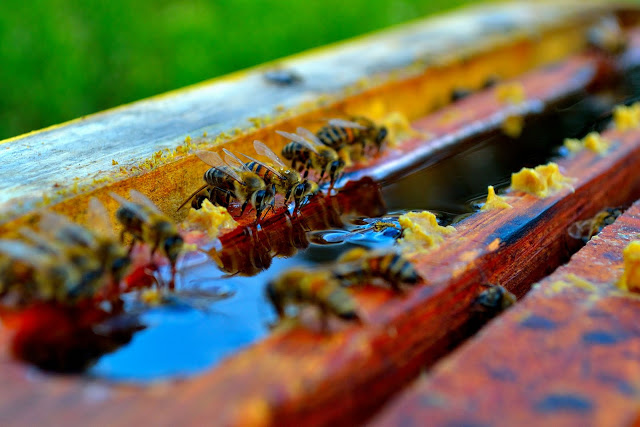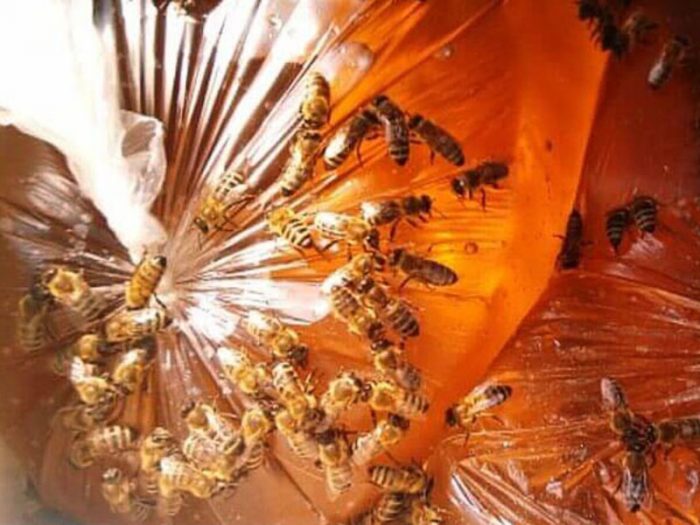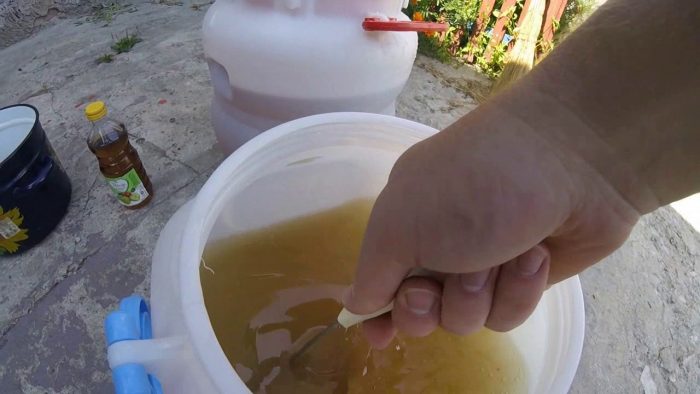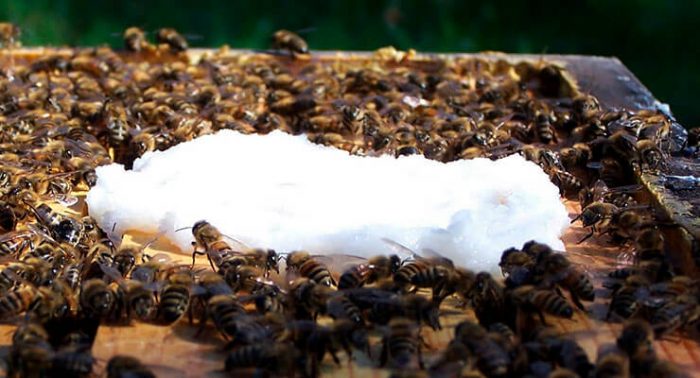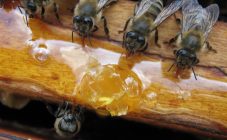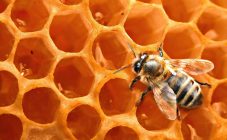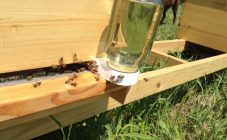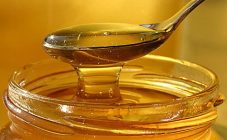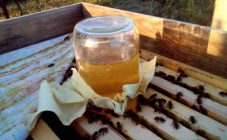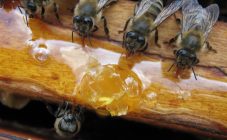Content:
Any beekeeper who cares about the safe wintering of bee offspring, after the end of the summer season, conducts an audit in bee hives in order to determine whether the honey stocks harvested by bees are enough until spring. If there is not enough honey, an autumn feeding of bees with sugar syrup is recommended.
Feeding bees in autumn with sugar syrup, timing
This procedure is carried out after the last pumping of honey in a certain period of time - from the 20th of August to mid-September. Sugar bees are fed in autumn at different times, depending on the region and climate.
If brood bees will process the sugar syrup, the bee colony will not survive until spring. Therefore, it is recommended to feed only strong families with sugar syrup.
Another important reason why feeding bees with sugar syrup must be completed before the first autumn frosts is that young individuals that are not yet able to fly around begin to defecate directly into the hives, which threatens the bees with a serious infection that risks killing all offspring. It should be remembered that the wrong timing for feeding the bees can cause irreparable harm to the life and health of these little hardworking creatures.
When should bees give syrup in autumn? Feeding the bees with sugar syrup in autumn is necessary in the following cases:
- If the bees have not managed to prepare the amount of honey they need for wintering, as mentioned above.
- If some honeycomb is not sealed.
- If you need to add any medication to prevent or treat infections.
- If honey in combs for one reason or another is candied.
Using bee feeding bags
How to feed sugar bees in autumn? There are several ways you can feed your bees. For this, the following can be installed in the hive:
- Special feeders attached to the walls of the hive.
- Empty frames.
- Three-liter glass jars.
The listed containers are filled with sugar syrup and installed directly into the hive. However, experienced beekeepers successfully use ordinary plastic bags to feed bees. This method is the least energy consuming, but more convenient in all respects.
Installation principle: a clean and dry bag is filled with ready-made sugar syrup, tied and folded onto the upper frames.
The bag is carefully covered with a propolis canvas and the hive is closed. The plastic bag, thanks to its porous structure, allows the odor to spread throughout the hive. A bee that finds a delicacy pierces the bag on its own and sucks out the syrup. However, some beekeepers use a thin needle to pierce the bag in several places before placing it in the hive.As a rule, a few days is enough for the sugar syrup to be eaten completely by the bees. The beekeeper will only have to remove an empty bag from the hive.
Choosing a syrup: how much do bees need
There are several varieties of sweet syrups for feeding bees in the fall:
- Sugar, based on 2 main components - sugar and water. If necessary, you can include there various additives in the form of herbal infusions, extracts or medicines needed for the prevention or treatment of bee infections.
- Inverted, based on natural honey.
- Honey fed, where natural honey is slightly diluted with water in a strictly allotted proportion.
The beekeeper should know that honey fed is most often used to increase bee brood in early spring. Sugar syrup remains the most popular autumn supplement among Russian beekeepers. Each beekeeper has his own unique recipe for making sugar syrup. The additives, tested by experience and time, are actively used. But there are a number of rules that every beekeeper must strictly follow:
- The best quality sugar must be used.
- It is preferable to use well, spring or previously treated water.
- To prepare the sugar syrup, you must use aluminum or enamel dishes.
- Sugar syrup is served to bees, it must be cooled to 30-40 degrees.
- Before pouring the syrup into the bag, make sure your hands are clean (no traces of cream or perfume). Harsh odors can irritate the bees.
The concentration of the sugar syrup can be as follows:
- 1: 1. For 1 kg of sugar, 1 liter of water is taken.
- 3: 2. It is the most optimal concentration for feeding bees in autumn.
Sugar syrup recipe:
- Pour 2 liters of water into a clean saucepan and bring to a boil.
- Add 3 kilograms of sugar and mix thoroughly.
- Cool the sugar syrup to 40 degrees.
- Pour the prepared syrup into a clean, dry bag and tie. The bee food is ready to install.
Syrup additives
Beekeepers successfully add various additives in the form of herbal infusions and extracts to sugar syrup. Supplements are designed to saturate the body of bees with nutrients and essential microelements, to increase the vitality and endurance of bees. For prophylactic or therapeutic purposes, special medications can also be used. The following supplements are most popular with beekeepers:
- In order to increase the immunity of bees, cobalt is added to complementary foods. Cobalt tablets are available over the counter. Typically, two tablets are sufficient for a 2 liter syrup.
- Conventional baker's yeast is successfully used as an additive to replenish the reserves of vitamins and trace elements. For 5 liters of syrup, you need about 125 grams. pressed yeast. If dry yeast is used, it must be diluted with water first.
- Fumagillin may be added to the sugar syrup to avoid bee infections. This is the most reliable remedy for combating bee nosematosis, which can be caused by prolonged rainy weather, late flight of bees, etc. It is necessary to dilute strictly in accordance with the attached instructions.
- Coniferous extract added to the sugar syrup will protect the hives from mites. The needles of pine and spruce are rich in vitamins and phytoncides, which have a beneficial effect on immunity. Its use increases resistance to infections and has a positive effect on the number of offspring of bee colonies.2 grams of the extract is mixed with half a glass of water and mixed with one liter of the finished sugar syrup. But be careful with this supplement! If the proportions are not observed, there is a risk of increased bee mortality. The amount of extract should be up to 4 grams per 1 liter of finished feed!
- The most popular supplement among beekeepers is 80% vinegar essence. 3-4 grams (approximately 1 tablespoon) is spread over 10 liters of syrup. There is an opinion that bees prefer slightly acidified syrup, wear less during its digestion and conserve energy.
- Perga is another favorite supplement for autumn bee feeding. Perga compensates for the missing substances in the sugar syrup.
Herbs for syrup to bees in autumn
The most popular herbs among beekeepers are:
- calendula,
- chamomile,
- motherwort,
- thyme,
- tansy,
- wild rosemary.
They have a beneficial effect on the body of bees, prevent the development of infections in the hive and have a beneficial effect on the endurance of insects. 50 grams of dry raw materials are poured with one liter of cold water and brought to a boil. Then it is cooled, filtered and added to the finished sugar syrup (for 1 liter of syrup 50 ml of the resulting infusion).
Bees, like humans, can suffer from diseases of the gastrointestinal tract. Diarrhea can be especially detrimental to them. This wears out the bee organism, and if the bee begins to defecate in the hive, there is a very high risk of infection spreading throughout the hive. Thus, the entire bee colony may die. For diarrhea in bees, oak bark has been successfully used. The finished herbal infusion is mixed with sugar syrup in a 1: 1 ratio.
Varroatosis is a disease that has killed more than one bee family. If a tick is found, medicinal syrup with a decoction of wormwood and needles will help. 100 g wormwood and 900 gr. needles are poured with 10 liters of water, boiled for 3 hours, then allowed to settle and filtered. For 1 liter of sugar syrup, 50 ml of infusion is used.
Thus, the correct proportions in the preparation of sugar syrup, suitable additives and the correct feeding time will ensure stamina and vitality of the bees. Successful and fruitful beekeeping!
